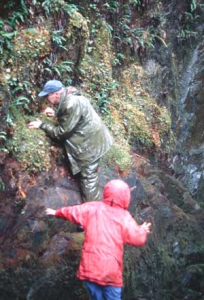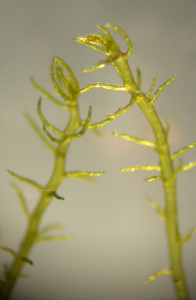 Bryophytes in the Class Takakiopsida are rarely found due to the scarce number of species and their specific habitats. There is one order (Takakiales), one family (Takakiaceae), and one genus (Takakia). Habitats are typically humid and terrestrial. Terrestrial substrates include rocks and banks near waterfalls located at sea or alpine level. There is a disjunction in distribution between North America and Asia, with species found between Alaska and British Columbia, and Japan and South East Asia.
Bryophytes in the Class Takakiopsida are rarely found due to the scarce number of species and their specific habitats. There is one order (Takakiales), one family (Takakiaceae), and one genus (Takakia). Habitats are typically humid and terrestrial. Terrestrial substrates include rocks and banks near waterfalls located at sea or alpine level. There is a disjunction in distribution between North America and Asia, with species found between Alaska and British Columbia, and Japan and South East Asia.
In the 1800’s, Class Takakiopsida was wrongly identified as part of the genus Lepidozia, a liverwort, due to the similarities in the gametophytic appearance. In 1957, sex organs were found on gametophytic shoots and Takakiopsida was identified as a type of moss.
The small gametophytic shoots are easily recognized by their bright green color. Growth of the shoots is acrocarpous. The misinterpretation in classification was partially due to the appearance of the leaves. Individual leaves are deeply lobed into 2-4 lobes and tapered at each apex. Further, the leaves are tristratose aiding in the cylindrical shape of leaves. Microscopically, the leaves contain oil droplets, common to liverworts (not mosses). There are also axillary hairs located at the base of leaves along the stem, likely aiding in mucilage production and moisture retention. However, the radial arrangement and transverse insertion of leaves on the stem differentiated these tiny bryophytes from being classified as a type of liverwort.
 The stems stand erect on the substratum and are unbranched or only have a few branches. Similar to mosses, the stem is cutinized and has a weak conducting strand. However, there are no rhizoids. Rather, there is a intercalary rhizome system that is not cutinized and new erect gametophytes arise from. Along the rhizome system clusters of beaked mucilage cells are present that may aid in moisture retention.
The stems stand erect on the substratum and are unbranched or only have a few branches. Similar to mosses, the stem is cutinized and has a weak conducting strand. However, there are no rhizoids. Rather, there is a intercalary rhizome system that is not cutinized and new erect gametophytes arise from. Along the rhizome system clusters of beaked mucilage cells are present that may aid in moisture retention.
As stated previously, the reproductive structures aided in classification of this moss. Common to other bryophytes, the reproductive structures are borne laterally close to the shoot apex. However, there are no modified perichaetial or perigonial leaves surrounding male and female reproductive structures. The archegonia are flask-shaped with a thick stalk and a neck composed of six or more rows of cells. The only species found that have antheridia are Takakia lepidozioides.
The sporophytic features, discovered only on Takakia ceratophylla in 1993, further confirmed classification as a moss. The seta is cutinized, has a conducting strand composed of hydroids, and elongates prior to maturation of the sporangium and spores.
The sporangium has features distinctly unique from other bryophytes. A thin calyptra protects the developing sporangium atop the elongated seta. The endothecium develops into the columella and spores, while the amphithecium develops into the sporangial jacket. Stomata are not present on the sporangial wall, indicating stomata are not likely a homologous characteristic of tracheophytes, mosses, and hornworts.
When the sporangium is mature, hygroscopic movements of the seta and sporangium aid in spore dispersal. As the sporangium twists the tension causes a single spiral longitudinal line of dehiscence to open along the sporangium, and spores are shed. The spores are unicellular and the events of germination are unknown, however it is assumed there is no protonemal stage. Asexual reproduction is accomplished by cauducous leaves and shoot apices.
SPECIES:
